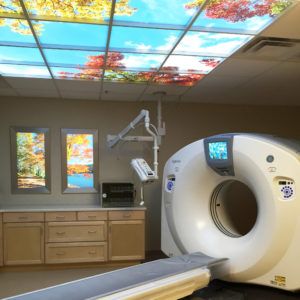Computed Tomography (CAT scan)
 Our 64-slice CT scanner gives our patients superior imaging in a comfortable environment.
Our 64-slice CT scanner gives our patients superior imaging in a comfortable environment.
Improved patient experience with shorter scan times, improved patient access and positioning, and a video of relaxing scenes or cartoons for children.
High Detail, Low Dose features offer the ability to see the smallest diagnostic detail with up to 60% dose reduction.
What is CT Scanning?
CT scanning (sometimes called CAT scanning) is a noninvasive medical test that helps physicians diagnose and treat medical conditions.
CT scanning combines special x-ray equipment with sophisticated computers to produce multiple images or pictures of the inside of the body. These cross-sectional images of the area being studied can then be examined on a computer monitor, printed or transferred to a CD.
CT scans of internal organs, bones, soft tissue and blood vessels provide greater clarity and reveal more details than regular x-ray exams.
What are some common uses of the procedure?
CT scanning is typically used to quickly identify injury related to trauma and help diagnose problems related to the internal organs such as:
- Infections, appendicitis, diverticulitis, pyelonephritis or infected fluid collections, aka. abscesses.
- Inflammatory processes such as pancreatitis, liver cirrhosis or inflammatory bowel disease such as ulcerative colitis or Crohn’s disease.
- Cancers of the colon, liver, kidneys, pancreas and bladder as well as lymphoma.
- Kidney and bladder stones.
- Abdominal aortic aneurysms (AAA) and other diseases of the arteries and veins such as blood clots and abnormal narrowings also known as stenoses of the vessels.
How does the procedure work?
In many ways CT scanning works very much like other x-ray examinations. X-rays are a form of radiation-like light or radio waves-that can be directed at the body. Different body parts absorb the x-rays in varying degrees.
In a conventional x-ray exam, a small amount of radiation is aimed at and passes through the body, recording an image on photographic film or a special image recording plate. Bones appear white on the x-ray; soft tissue, such as organs like the heart or liver, shows up in shades of gray and air appears black.
With CT scanning, numerous x-ray beams and a set of electronic x-ray detectors rotate around you, measuring the amount of radiation being absorbed throughout your body. At the same time, the examination table is moving through the scanner, so that the x-ray beam follows a spiral path. A special computer program processes this large volume of data to create two-dimensional cross-sectional images of your body, which are then displayed on a monitor. This technique is called helical or spiral CT.
CT imaging is sometimes compared to looking into a loaf of bread by cutting the loaf into thin slices. When the image slices are reassembled by computer software, the result is a very detailed multidimensional view of the body’s interior.
Refinements in detector technology allow new CT scanners to obtain multiple slices in a single rotation. These scanners, called multislice CT or multidetector CT, allow thinner slices to be obtained in a shorter period of time, resulting in more detail and additional view capabilities.
Modern CT scanners, like the one at UBMC, are so fast that they can scan through large sections of the body in just a few seconds, and even faster in small children. Such speed is beneficial for all patients but especially children, the elderly and critically ill.
For children, the CT scanner technique will be adjusted to their size and the area of interest to reduce the radiation dose.
For some CT exams, a contrast material is used to enhance visibility in the area of the body being studied.

